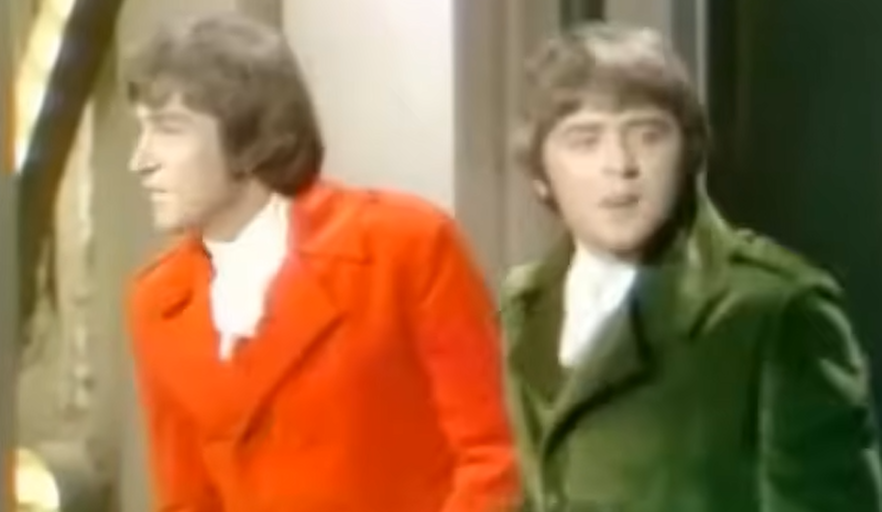A career that had brought millions of people joy was forever marred by Tommy Boyce’s death in 1994. The songwriter, who wrote some of the most memorable songs of the 1960s, died in Nashville at the age of 55. His remarkable body of work and eerie reminder of the difficulties creative minds frequently encounter are both left behind. He never fully recovered from a 1993 brain aneurysm, which led to his death. He was described by friends as restless but endlessly creative, a man who was always humming tunes, and his untimely death felt remarkably similar to the tragic deaths of other music icons, such as his close friend Del Shannon.
Instead of tragedy, Boyce’s life was characterized by victories that changed the direction of popular music. His collaboration with Bobby Hart is still among the most remarkably successful in pop history. With songs like “Last Train to Clarksville,” “Valleri,” and the instantly identifiable theme song that millions of teenagers sang along to every week, they collectively formed the Monkees’ sonic core. The optimism and turbulence of the 1960s were remarkably reflected in their songs, which were full of youthful energy and catchy hooks. In many respects, they served as the background music for a generation that was negotiating both change and innocence.
The two had a much wider audience than just the Monkees. As evidence of their continuing cultural impact, Boyce and Hart wrote the theme for Days of Our Lives, a program that is still broadcast today, decades after it first debuted. They wrote hits for Paul Revere and the Raiders, Little Anthony and the Imperials, and Jay and the Americans. Later, Linda Ronstadt performed a cover of one of their songs, showcasing how extremely versatile their work was, effortlessly spanning decades and genres. With more than 300 songs sold and over 42 million records sold, the duo would rank among the most successful songwriters in history.
Tommy Boyce – Bio & Career Overview
| Category | Details |
|---|---|
| Full Name | Sidney Thomas “Tommy” Boyce |
| Born | September 29, 1939 – Charlottesville, Virginia, United States |
| Died | November 23, 1994 – Nashville, Tennessee, United States (aged 55) |
| Cause of Death | Suicide, following long-term health struggles and a brain aneurysm |
| Occupation | Singer, Songwriter, Producer |
| Partner | Bobby Hart (Boyce & Hart songwriting duo) |
| Major Works | “Last Train to Clarksville,” “Valleri,” “I Wonder What She’s Doing Tonight,” “(Theme from) The Monkees” |
| Associated Acts | Boyce & Hart, The Monkees, Dolenz, Jones, Boyce & Hart |
| Legacy | Wrote over 300 songs, selling more than 42 million records worldwide |
| Authentic Source | Tommy Boyce – Wikipedia |

Boyce and Hart encountered the ebb and flow of celebrity despite their achievements. Together with Micky Dolenz and Davy Jones of the Monkees, they formed Dolenz, Jones, Boyce & Hart in the middle of the 1970s. Despite the project’s nostalgic energy, its commercial success was limited. Nevertheless, despite shifting musical trends, the experiment demonstrated their perseverance and will to continuously reinvent themselves. Their international tours, which included being the first American band to perform in Thailand, allowed them to reach audiences far from their home base.
Tommy Boyce was well-known as a mentor in addition to being a songwriter. His book How to Compose a Successful Song and Market It It was especially helpful for up-and-coming musicians hoping to establish themselves. In the UK, he produced records, worked with bands like Darts and Meat Loaf, and kept writing until his health deteriorated. He was a mile-a-minute idea generator, according to those who collaborated with him, spewing out riffs and phrases that Hart meticulously honed into completed songs. They had a very effective dynamic that combined Hart’s methodical craftsmanship with Boyce’s unrestrained creativity.
His passing, however, brought to light the quiet struggles that frequently accompany creative genius. Like Kurt Cobain only months before or Shannon before him, Boyce’s decision to take his own life demonstrated the burden of illness, depression, and creative exhaustion. In his parting message, he wished to be reunited with his mother, Del Shannon, and Elvis Presley, connecting his life to a group of legendary figures whose lives were also characterized by abrupt endings. His legacy gained poignancy from this tragic connection, which placed him within a larger story about the unspoken costs of celebrity.
Boyce was frequently referred to by Bobby Hart, who died in 2025, as the catalyst for their collaboration. He was referred to by Hart as “a mile-a-minute” creator, and Hart served as the filter, accepting the concepts that were successful and rejecting the ones that weren’t. They were the “essence” of The Monkees’ sound, according to Micky Dolenz, the last living member of the band. The group’s TV antics would have been meaningless without Boyce and Hart, Dolenz pointed out. Their music gave the humor substance and vitality, which made it incredibly timeless.
One cannot overlook Boyce’s story’s influence on society. As awareness of mental health in the arts grew, so did his passing. The quiet battles of forebears like Boyce are echoed decades later by artists like Shawn Mendes and Demi Lovato, who openly discuss their battles with depression and anxiety. His story serves as a reminder that even people who bring happiness to millions of people could be silently burdened, and it has sparked discussions about how the industry currently supports its stars in particularly creative ways.
Boyce’s music is still relevant today. While streaming services have exposed his catalog to younger audiences, oldies stations continue to play “I Wonder What She’s Doing Tonight.” His meticulously constructed melodies are far more resilient to the test of time than many experimental songs from the same era. This longevity is a tribute to his skill as well as the universal feelings his songs evoked, such as love, longing, and carefree youth.

